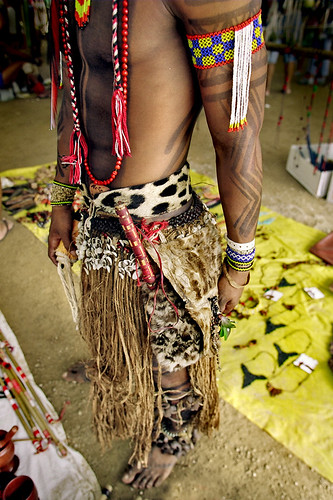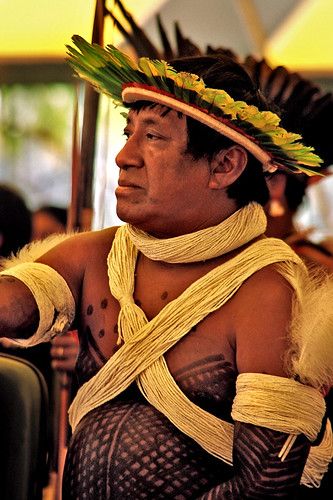2005/05/06
The Indigenous Social Forum
"Traditions, Globalization and New Perspectives",
and a fair to sale their handicraft.
They were waiting for the beginning.
We had come early.
Those are Pareci People wich live at Chapada dos Parecis,
on Mato Grosso State from Brazil.
Population about 1.293, in 1999.
All photos here were taken on the Indigenous Nacional Party, realized by the Intertribal Committee (ITC) with the town hall's Bertioga City support, in São Paulo State. (April, 2005)
the Wazare myth
The Pareci's myth of creation tells they were birth from a stone, led by a mythical hero called Wazare, which had spread them from all the land. After Wazare finished his mission distributing the Pareci People on the Pareci's Chapada, he did a big confraternization's party before going back to his world.
During this party he taught the functions from the head, from the mind, commanding the body, and our capacity to develop intelligence while finding mental and spiritual fullness. He did it teaching the Xikunahity, the "head soccer".
Pareci body art
They call themselfs as Haliti,
which means "people", "human being".
Indigenous leader Marcos Terena
He were talking to other leaders at the Indigenous Social Forum "Traditions, Globalization and New Perspectives", to other leaders.
He is the unique Latin American indigenous spokespeople on the UN.
To know more about Marcos Terena, follow this link:
Call of the Earth - biography
women dancing
They were Canela People.
This dance made a kind of hypnosis sensation.
While they were reapeatting their words and shaking the rattles, the women was swinging subtle their bodys, and the arms were waggling.
Was fascinating for me to see their arms going to front and behind the body, all synchronized.
The Canela People live in Maranhão State from Brazil.
They were divided in two sub-groups: Ramkokamekrá and Apanyekrá.
Population about 1.337 Ramkokamekrá (in 2001) and 458 Apanyekrá (in 2000).
Pataxó beauty
They were waiting to the beginning of their ritual.
I really like the fact of this pretty woman was looking to the opposite side from everyone.
Even when we have the identity, the roots, is always good to keep the eyes open from every view sides. Keep your mind open, in many ways.
The Pataxó People lives in Bahia State from Brazil.
Population about 2.790 (in 1998)
Pataxó warrior
The Pataxo have long found themselves embroiled in conflicts over territory. Although their territories were "demarcated" in the 1930s, they were progressively marginalized by ranchers and other outsiders. In 1999 they made international headlines by occupying Monte Pasqual National Park, demanding the return of their traditional lands, and in the following year were highly visible again in protests surrounding the 500th anniversary of European "discovery" of Brazil.
They are still fighting, as you can see here in my old set from the V World Social Forum, where they did some protests.
Ubiranan is his name.
It means "Great Warrior's son".
fashioned
Ubiranan was wearing all those indigenous stuff.
I couldn't know where to look first.
Pataxó handicrafts
Located just 90 minutes from a major beach area, the community sees carefully managed tourism as a potential source of environmentally sustainable development that
could contribute to cultural preservation, giving youth an opportunity to remain in the area rather than drifting
to the cities.
Their village has embraced a return to its roots, an emphasis on reinvigorating traditional songs, dances, ceremonies, and even food and dress.
Pataxó whistle
When i saw this piece of wood on the ground with the handicrafts, I asked him what it was.
He wanted to show me, and made amazing bird's sounds.
I still don't know who was more concentrated,
he blowing the whistle
or me shooting his portrait
while listening the bird's sound through him.
All around was silence.
If i'm not wrong, his name is Matiguti,
which means tree's forest with big fruit :)
Gavião's chief
Gavião means hawk.
The Gavião People live in Rondônia State from Brazil.
Population about 436 (in 2000).
cinnamon skin
The Canela People compare formal friends to godfathers and godmothers or the godparents of a wedding, relationships which are common in the interior.
There is a special respect between these men and women, who should be reciprocally served, honored, and protected.
Her portuguese name is Eliana.
Canela means cinnamon.
The Canela People live in Maranhão State from Brazil.
They were divided in two sub-groups: Ramkokamekrá and Apanyekrá.
Population about 1.337 Ramkokamekrá (in 2001) and 458 Apanyekrá (in 2000).
no eyebrowns
There is something curious from the Canela People.
I was looking their faces and i could always recognize them.
So, i realize they don't have eyebrowns.
They take off with medicine herbs.
I couldn't find why.
Here this father was showing to the baby counting numbers with his fingers.
Nambikwara girl
She was looking through me
and she was happy :)
Her portuguese name is Cida.
The Nambikwara live on the Mato Grosso State's
west and Rondônia State from Brazil.
Population about 998, in 1999.
future
"We the Indigenous Peoples are moving towards the future along the trails left by our forefathers.Indigenous leader Marcos Terena
This is our culture.
This is our strength,
the spiritual strength that mankind is loosing...
Don't play with the spirit.
Your spirit is holy.
Your spirit is sacred.
It is your strength. Not anybody else's strength."
The Nhambikwara woman and child.
circle of life
"Indigenous Peoples are united by a circle of life,
It's a circle of life that circles the Earth, waters,
the air, what you call... the environment.
We who believe are most familiar with nature ...
you must become our allies.
Do not fear us because the future of the
Indians is your future too.
And it is also the future of the planet."
Indigenous leader Marcos Terena
Nhambikwara woman dancing their "teenage-girl's ritual"
Asurini People
"They say the universe was first created, but then it was flooded and the earth ceased to exist, 'it became soft.' From this misfortune, only one man survived, sheltered at the top of a bacabeira tree. It was then that Mahira summoned tapir for the animal to harden the surface of the earth. Mahira also extracted his own rib, transforming it into a woman, which allowed the human population to increase."
Lúcia Andrade, Pro-Indian Commission - São Paulo, from ISA
The Asurini People live in Pará State from Brazil.
Population about 303 (in 2001).


















